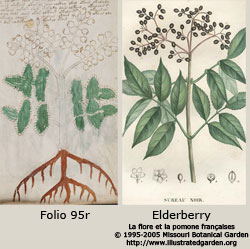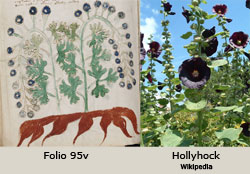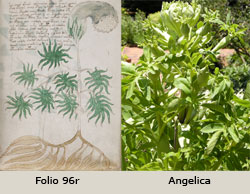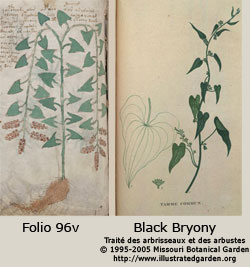The Voynich Botanical Plants
Folio 95r, Elderberry (Sambucus nigra), is a small deciduous tree native to most of the Northern hemisphere. In the summer the tree has masses of flat-topped white flower heads. The leaves are arranged in opposite pairs of five to seven odd pinnate leaflets with serrated edges. Drooping clusters of black berries ripen in the late fall. (The berries shown in Folio 95r are colorless, this may be due to the author having, on occasion, an inadequate supply of different colored “paints.”) The berries are used to make jams and wine. Italian peasants still construct a simple wind instrument from the hollow branches. Pliny the Elder (23–79) wrote that boys made pop-guns and whistles from the branches of this tree.
Folio 95v, Hollyhock (Althaea Rosea), is a member of the mallow family that was imported into Europe from China. It is a biennial often found growing in clumps. The roots are thick (tuberous), long, and tapering; the leaves are broad and palmate; and the purple, red, pink, or yellow flowers are used to make dyes. They may also be used in skin moisturizers.
Folio 96r, Garden Angelica (Angelica archangelica), is a large European plant with thick, fleshy, spindle-shaped roots. Its hollow stems are 4-6 feet in height and its bright green leaves are made up of numerous small leaflets. Like other members of the carrot family, the small yellowish flowers are grouped in large umbrels, that produce pale yellow oblong fruit when ripe. According to one legend, an angel revealed in a dream that Angelica could cure the plague. The plant was held in such esteem that it was called “The Root of the Holy Ghost.” Today Angelica is grown mainly for its stems that are candied and used to decorate cakes and confections.
Folio 96v, Black Bryony (Tamus communis), is an herbaceous vine native to Europe and Northwestern Africa. The heart-shaped, pointed leaves are spirally arranged along the twining stem. The vine has separate male and female plants, both with small, greenish-yellow flowers, the latter being succeeded by red berries when ripe. It is very similar to a yam with a large fleshy black tuberous root. The vine, including the root, is poisonous. Juice from the root has been used with great care as a diuretic. The berries act as an emetic when eaten.



